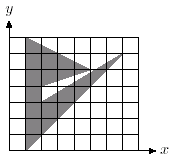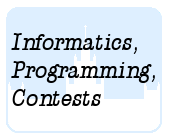Подразделы
Другие разделы
| Занятие 1 |
| Занятие 2 |
| Занятие 3 |
| Занятие 4 |
| Занятие 5 |
| Занятие 6 |
| Занятие 7 |
| Занятие 8 |
| Занятие 9 |
| Занятие 10 |
| Занятие 11 |
| Занятие 12 |
| Занятие 14 |
| Занятие 15 |
| Занятие 16 |
| Занятие 17 |
| Занятие 18 |
| Занятие 19 |
| Занятие 20 |
Дата и время
23/12/2025 20:27:59
 Занятие 13
Занятие 13
A. ASCII Art B. Billing Tables C. Cellular Automaton D. Driving Directions E. Exchange F. Fool's Game G. Graveyard H. Hard Life I. Interconnect J. Java vs C++ K. Kickdown
 A. ASCII Art
A. ASCII Art
 Вычислительная геометрия
Вычислительная геометрияОлимпиадные задачи на английском языке

| 12/12/2006 | Практическое занятие 13 (задачи NEERC 2006) (A) |
Ограничения: время – 3s/6s, память – 64MiB Ввод: input.txt или стандартный ввод Вывод: output.txt или стандартный вывод 
Послать решение Blockly Посылки Темы Где Обсудить (0)
ASCII art is an art of creating pictures with a grid of ASCII characters. There are many styles of ASCII art, but we are interested in the most primitive one, where just an overall character density is used to represent differently shaded areas of the picture.
You should write a proof-of-concept program that renders a filled closed polygon with a rectangular grid of ASCII characters. The whole process is explained in detail below.
Let `"OXY"` be a Cartesian coordinate system with `"OX"` pointing to the right and `"OY"` pointing up. Drawing canvas is bounded with (0; 0) – (`w;\ h`) rectangle. Pixels on the canvas are (`x;\ y`) – (`x` + 1; `y` + 1) squares where `x` and `y` are integers such that `0\ ≤\ x\ <\ w` and `0\ ≤\ y\ <\ h`. A filled closed polygon without selfintersections and self-touchings (but not necessarily convex) is drawn on the canvas. Pixels of the canvas become partially filled during the process. Each pixel is represented by an ASCII character depending on the percentage of its filled area according to the following table:
| Pixel percentage area filled | Character name | Glyph | ASCII code |
| From 0% inclusive to 25% exclusive | Full stop | . | 46 |
| From 25% inclusive to 50% exclusive | Plus sign | + | 43 |
| From 50% inclusive to 75% exclusive | Small letter o | o | 111 |
| From 75% inclusive to 100% exclusive | Dollar sign | $ | 36 |
| 100% | Number sign | # | 35 |
The resulting ASCII characters for all pixels are printed top-to-bottom and left-to-right to get a visual representation of the drawing.

Input
The first line of the input file contains integers `n,\ w,` and `h\ (3\ ≤\ n\ ≤\ 100,\ 1\ ≤\ w;\ h\ ≤\ 100)` — number of vertices in the polygon, width and height of the canvas respectively. The following `n` lines contain coordinates of the polygon vertices in clockwise order. Point `i` is described by two integers `x_i` and `y_i` (`0\ ≤\ x_i\ ≤\ w,\ 0\ ≤\ y_i\ ≤\ h`).
Output
Write to the output file `h` lines with `w` ASCII characters each that represent ASCII art drawing of the given polygon.
Sample Input
6 8 7 7 6 1 0 1 7 5 5 2 4 2 3
Sample Output
.$+..... .##$+... .#$oo+.. .#+$o... .##o.... .#o..... .o......

 Начало
Начало